|
The Search for a Lost British Bomber in a Lake near Berlin
At the beginning of World War II, Commander-in-Chief of the German Luftwaffe Hermann Göring declared during a radio address: "No enemy bomber can reach the Ruhr. If one reaches the Ruhr, my name is not Göring. You may call me Meyer.” The joke lay in the fact that the name was common and undecorated in Germany at the time. However, only a few years later, Adolf Hitler’s trusted advisor and war-chief was forced to make good on his promise. In 1940, Göring apparently introduced himself as Herr Meyer on arrival at a Berlin air-raid shelter while taking refuge from one of the many Allied bomber units that had started to decimate Germany’s cities.
As the Allied air-raids got underway that year, the Americans would send B17 bombers to Germany during the daytime with P51 Mustangs as escorts, and at night the British would arrive with an air fleet of heavy bombers. The Brits flew under the protection of darkness, mostly without any backup. On Christmas Eve, 1943, the decision to fly unprotected would not only cost several British pilots their lives, but also leave an underwater war-relic at the bottom of a Berlin lake. Over 75 years later, I decided to hunt down the sunken artifact...
|
|
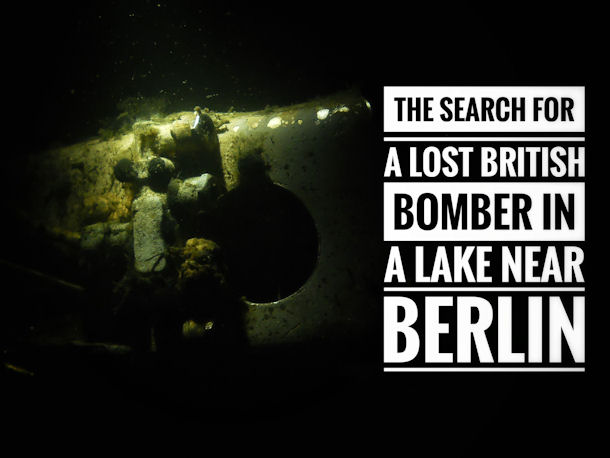
|
|
A Plane Goes Down on Christmas Eve
|
|
At 11.45 PM on December 23, 1943, a group of Royal Air Force bombers took off from the English settlement of Kelstern, headed for Berlin. Among the 625th Squadron Bomber Command was a Lancaster BI, bearing the identification code LM421 CF-Q. The four-engine aircraft had only been in service since December 4, 1943 and had been fully operative for just 17 hours. There were seven people on board the plane: Commander Sergeant Geoffrey Francis Clark, flight engineer Sergeant Ralph Parkinson, navigator Sergeant Donald William Walker, radio operator Sergeant William Edward Whitmarsh, bombardier Sergeant Arthur Edward Nayler, and shooters Sergeant Charles Ronald Harrison and Frank Arthur Sugden.
|
|
In the early hours of the festive morning, the English bomber was intercepted and fired upon by a German night fighter just south of Berlin at an altitude of 6,000 meters. The Lancaster shooters fired from their eight 7.7 mm machine guns, installed in the twin towers of the nose of the aircraft, on top of the fuselage and in the aircraft’s rear quad tower. But the plane was heavily damaged. The crew attempted an emergency landing while their tanks were ablaze. At 4.10 AM the plane crashed into a lake south east of Berlin, the Motzener See. Apparently it was Lieutenant Georg Fenk of the 11th Season of Night Fighter Squadron 5 (11th /NJG 5) who fired the shot that brought the Lancaster down. Locals from the nearby settlements of Motzen and Kallinchen reported seeing an explosion when the plane hit the water. I came across the following eyewitness report from Mr. Herbert Siecke at the local Motzen museum, Heimatverein Motzen:
|
|
"Once again, there was an air raid warning at night in December. At that time I was 16 years old and had been assigned the role of detector at the community hall in the Splittergraben. Present were the air raider P. Rudolph and the head of the fire brigade W. Hahn. It was cloudy and windy, when suddenly we heard the sound of airplanes above the clouds, MG salvos and shots of the cannon of the night fighter that caused the British bomber to crash. Very strong rustling noises started, we went with our heads ever deeper in our splinter trench, which were followed by a fiery inferno and explosion before the airplane disappeared into the Motzener Lake. Burning kerosene covered the entire crash area. Soon after, we were given the all-clear, then we went immediately with the fire brigade to the settlement’s bathing spot. There we found hundreds of dead fish, airplane parts and an open parachute floating towards the shore.
To assist us, we had a barge and shovels from the fire brigade that we used as oars to get to the parachute. It was, as previously stated, stormy and there was a strong swell, and we had a lot of trouble getting the empty parachute into the barge. The parachute and parts of the plane were brought to the fire station where they were picked up.
That night and that operation, I’ll never forget."
|
|
|
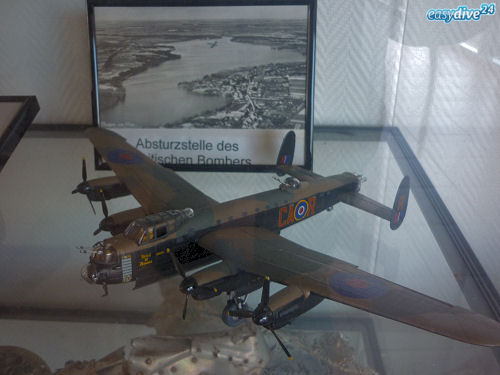 |
|
The seven crew members did not survive the crash. Commander Clark and the riflemen Nayler, Harrison and Sugden are buried at the Commonwealth War Graves Cemetery in Berlin-Charlottenburg (graves 5.E.7 to 5.E.10). The bodies of engineer Parkinson, navigator Walker and radio operator Whitmarsh are still missing. Their names have been immortalized at the Runnymede Memorial in Surrey, England.
|
|
At first, we had very little information about the resting place of the downed bomber. Only one map of the supposed crash site had been published, with only the image of a footbridge on the Motzen side of the lake and a noteworthy tree on the opposite shore as bearing points.
|
|
During our first dive, we looked for the crash site at random, this method leading to an hour-long search through the cold dark waters as mud and sediment swirled upwards from the bed of the lake. Finally, my heart skipped a beat as I saw a large object in the murky water. Swimming over in great excitement, I made a closer inspection. With such poor visibility, my mask was half a meter away from the object before I realized it was an old oar sticking out of he mud.
|
|
Having failed to locate the underwater aircraft on our first attempt, we planned our second dive more thoroughly. First, we found out some extra information about the crash site. Several parts of the plane on show at a local fishing hut bore witness to the fact that there wasn’t just fish to be found in the depths of the lake. We talked to the fisherman who had discovered them and he told us where we had to focus our hunt. Returning to the depths of Motzener See, this time searching around the other side of the lake, we found a large part of a plane buried deep in the mud. We drove home happy, sure that we had found the crash site of the British Lancaster bomber.
|
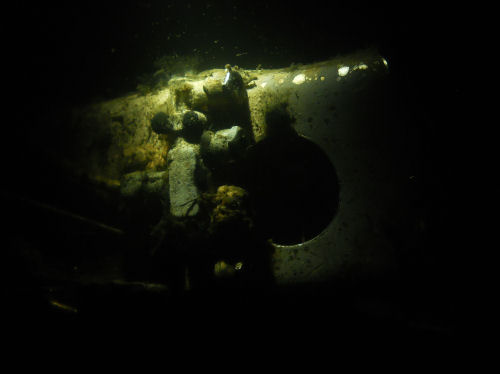 |
|
|
Divers have been looking for the wreck since the early 1960s. During this time, an unfortunate accident is said to have taken place. As the search for the plane was in in full swing, several young divers apparently came across a broadly scattered field of debris. Further information on the location can be found in the article “Aircraft Wreckage in Motzener Lake" (Poseidon 9/1963, p. 1 ff.). Students from the surrounding area of Motzen reportedly took the recovered parts and sold them to a scrap metal dealer. Obviously there are some bigger parts of the plane still left in the lake, and hopefully, this time round, they won’t come into the hands of anyone looking to make a quick buck.
|
Regrettably, the wreck of another B-17 bomber found at the bottom of Liepnitzsee lake, just north of Berlin, met a similar fate to the Christmas Eve aircraft, after the remnants of the plane were also sold off as scrap metal. You’d think that professional metal handlers would be able to discern between a hunk of junk and a priceless WWII relic, but it looks like as long as there are planes at the bottom of Berlin’s lakes, scrap metal dealers will continue to weigh and pay for the city’s underwater artifacts.
|
|
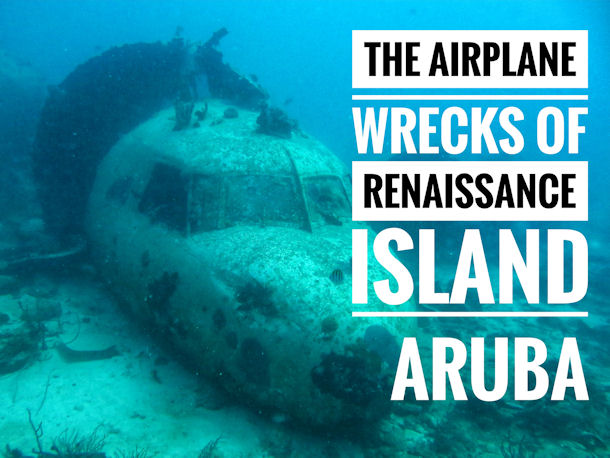
The Airplane Wrecks of Renaissance Island (Aruba)
It is possible to find A Convair CV 240 lying some 300 meters off the shores of Aruba’s Renaissance Island at a depth of only 12 meters. This particular machine is said to have been confiscated at the end of the 1980s during a drug raid. Just a few breaststrokes away from the Convair wreck lies the remains of a former YS-11 passenger aircraft, one of three models employed by Air Aruba for scheduled flights in 1988. Following the bankruptcy of Air Aruba in October 2000, the YS-11 found a new purpose as an artificial reef.
[read more]
|
|
|
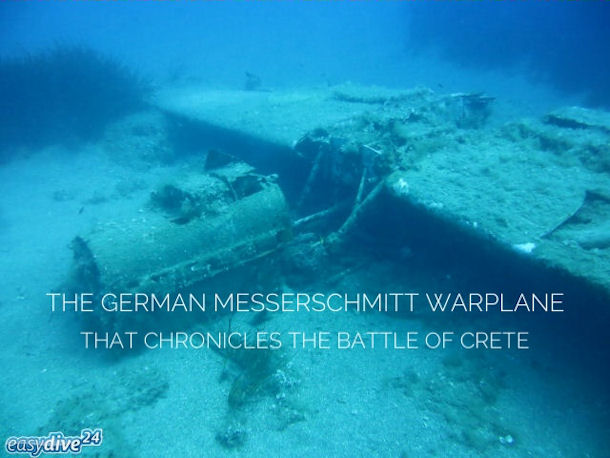
An Aegean Wreck: The German Warplane that Chronicles the Battle of Crete
About 800m off the coast of the small village of Anissaras near Hersonissos (Chersónissos) on the Greek island of Crete lies one of the most famous dive sites in the Mediterranean Sea. At the bottom of the Aegean Sea, at a depth of 24m, lays the well-preserved wreckage of a German World War II Messerschmitt Bf 109 fighter. The question is, was the German airplane shot down during "Operation Mercury" in May 1941?
[read more]
|
|
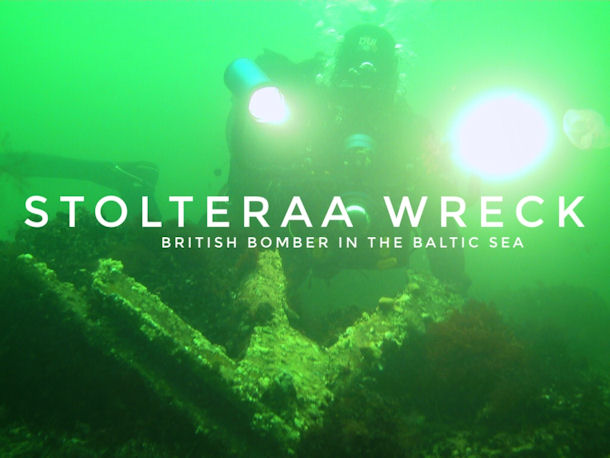
Stolteraa Wreck - Lost British Bomber on Baltic Sea near Warnemünde
Just off from Stolteraa, a small stretch of coast on the Baltic Sea near Warnemünde, lies in a depth of 6 m the wreck of an English bomber. The remains of the plane are located 1.5 nm west of the lighthouse in the area. Theoretically, the spot can be reached by swimming from land. To get there and back, however, it is approximately 1,400 m, a distance not to be underestimated. Therefore it’s preferable to dive by boat.
[read more]
|
|
|
|
|
The opinions of other divers are both incredibly interesting and helpful to us. Through the experiences of other travellers, we have been able to uncover many useful tips and gain wonderful insight into other countries, as well as finding out about accommodation, the local community, and various activities, all in advance of arriving at our planned destination. Therefore, we would be very pleased to receive any other travel reports on the topic of diving & snorkelling in Germany, which we would gladly present here on our website. Simply contact us at info @ easydive24.de
|
|
|


